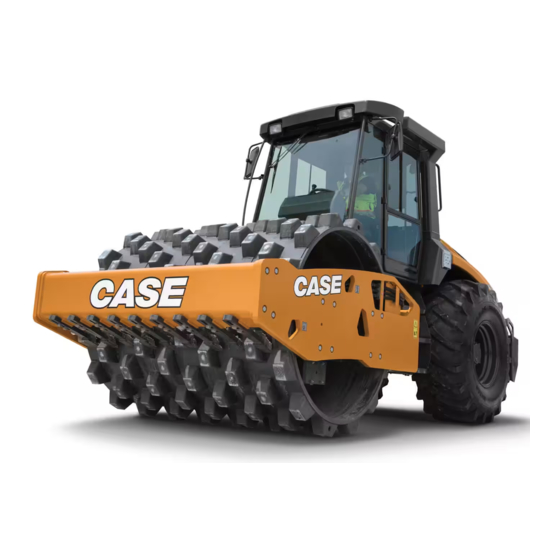
Summary of Contents for Case SV212D
- Page 1 SV212D SV216D Tier 4B (final) Vibratory Roller SV212D - DDDS212DNHWTB3010 and above SV216D - DDDS216DNHWTC3001 and above SERVICE MANUAL Part number 51429076 edition English April 2018...
- Page 2 SERVICE MANUAL SV212D SV216D 51429076 03/04/2018...
- Page 3 Contents INTRODUCTION Engine..................10 [10.001] Engine and crankcase ............. 10.1 [10.400] Engine cooling system .
- Page 4 Cab climate control ..............50 [50.100] Heating ................50.1 [50.200] Air conditioning .
- Page 5 Thanks very much for your reading, Want to get more information, Please click here, Then get the complete manual NOTE: If there is no response to click on the link above, please download the PDF document first, and then click on it. Have any questions please write to me: admin@servicemanualperfect.com...
- Page 6 51429076 03/04/2018...
- Page 7 INTRODUCTION 51429076 03/04/2018...
- Page 8 Contents INTRODUCTION Foreword - Important notice regarding equipment servicing ........3 Safety rules .
- Page 9 In any case, no warranty is given or attributed on the product manufactured or marketed by the manufacturer in case of damages caused by parts and/or components not approved by the manufacturer.
- Page 10 INTRODUCTION Safety rules Personal safety This is the safety alert symbol. It is used to alert you to potential personal injury hazards. Obey all safety messages that follow this symbol to avoid possible death or injury. Throughout this manual you will find the signal words DANGER, WARNING, and CAUTION followed by special in- structions.
- Page 11 INTRODUCTION Personal safety General safety rules Use caution when you operate the machine on slopes. Raised equipment, full tanks and other loads will change the center of gravity of the machine. The machine can tip or roll over when near ditches and embankments or uneven surfaces.
- Page 12 INTRODUCTION Before you leave the machine: 1. Park the machine on a firm, level surface. 2. Put all controls in neutral or park lock position. 3. Engage the parking brake. Use wheel chocks if required. 4. Lower all hydraulic equipment — Implements, header, etc. 5.
- Page 13 INTRODUCTION Incorrect towing procedures can cause accidents. When you tow a disabled machine follow the procedure in this manual. Use only rigid tow bars. Stop the engine, remove the key, and relieve pressure before you connect or disconnect fluid lines. Stop the engine and remove the key before you connect or disconnect electrical connections.
- Page 14 INTRODUCTION Wheels and tires Make sure that tires are correctly inflated. Do not exceed any recommended load or pressure. Follow the instructions in the manual for proper tire inflation. Tires are heavy. Handling tires without proper equipment could cause death or serious injury. Never weld on a wheel with a tire installed.
- Page 15 INTRODUCTION At least once each day, remove debris accumulation around moving components such as bearings, pulleys, belts, gears, cleaning fans, etc. More frequent cleaning of your machine may be necessary depending on the operating environment and conditions. Inspect the electrical system for loose connections and frayed insulation. Repair or replace loose or damaged parts. Do not store oily rags or other flammable material on the machine.
- Page 16 INTRODUCTION General battery safety Always wear eye protection when you work with batteries. Do not create sparks or have open flame near a battery. Ventilate the area when you charge a battery or use a battery in an enclosed area. Disconnect the negative (-) terminal first and reconnect the negative (-) terminal last.
- Page 17 INTRODUCTION Seat belts Seat belts must be worn at all times. Seat belt inspection and maintenance: • Keep seat belts in good condition. • Keep sharp edges and items than can cause damage away from the belts. • Periodically check belts, buckles, retractors, tethers, slack take-up system, and mounting bolts for damage and wear.
- Page 18 INTRODUCTION Operator protective structure Your machine is equipped with an operator protective structure, such as: a Roll Over Protective Structure (ROPS), Falling Objects Protective Structure (FOPS), or a cab with a ROPS. A ROPS may be a can frame or a two-posted or four-posted structure used for the protection of the operator to minimize the possibility of serious injury.
- Page 19 INTRODUCTION The audible backup alarm system notifies others in the area that the machine will be or is moving in reverse. Personal Protective Equipment (PPE) Wear Personal Protective Equipment (PPE) such as hard hat, eye protection, heavy gloves, hearing protection, pro- tective clothing, etc.
- Page 20 INTRODUCTION Applied chemicals require additional precautions. Obtain complete information from the manufacturer or distributor of the chemicals before you use them. Utility safety When digging or using ground-engaging equipment, be aware of buried cables and other services. Contact your local utilities or authorities, as appropriate, to determine the locations of services.
- Page 21 INTRODUCTION Lifting and overhead loads Never use loader buckets, forks, etc. or other lifting, handling, or digging equipment to lift persons. Do not use raised equipment as a work platform. Know the full area of movement of the machine and equipment and do not enter or permit anyone to enter the area of movement while the machine is in operation.
- Page 22 Improper disposal of batteries can contaminate the soil, groundwater, and waterways. CASE CONSTRUCTION strongly recommends that you return all used batteries to a CASE CONSTRUCTION dealer, who will dispose of the used batteries or recycle the used batteries properly.














Need help?
Do you have a question about the SV212D and is the answer not in the manual?
Questions and answers